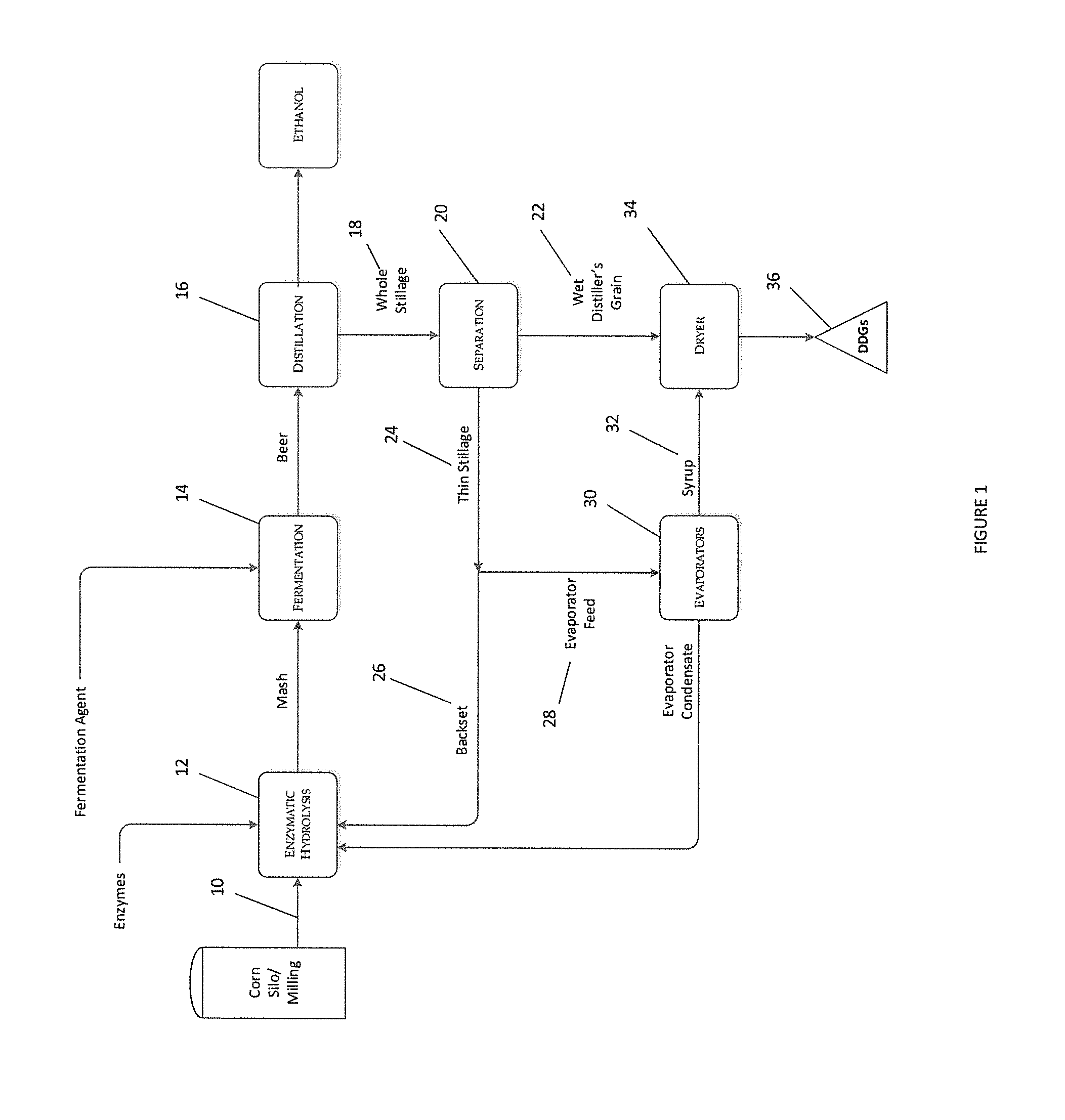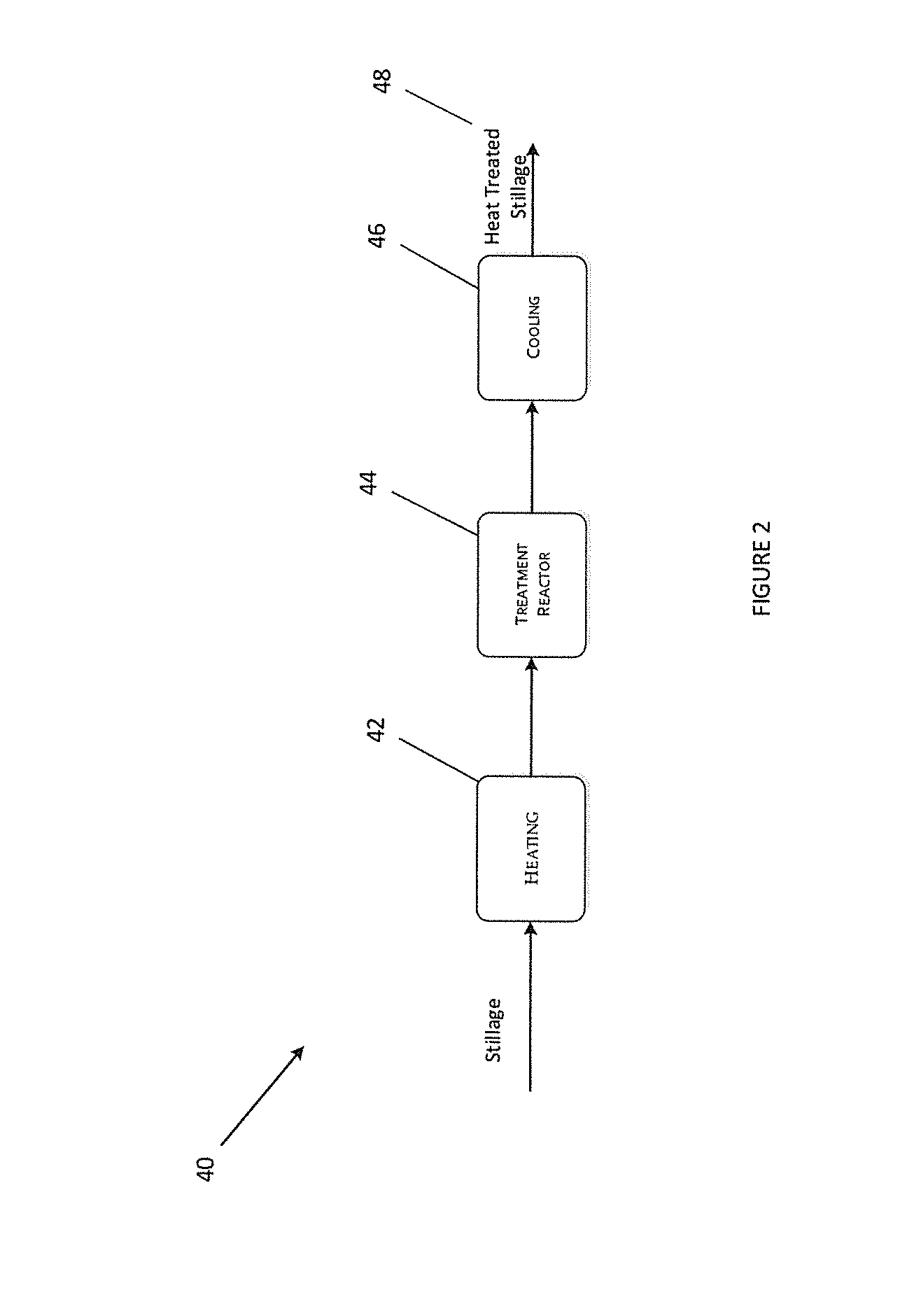Protein product
a technology of protein and product, applied in the field of protein products, can solve the problems of blood acidification, debility, cloacitis and cannibalism, distiller's grain products produced with current art have limitations, etc., and achieve the effect of superior animal feed components
- Summary
- Abstract
- Description
- Claims
- Application Information
AI Technical Summary
Benefits of technology
Problems solved by technology
Method used
Image
Examples
example 1
Physicochemical Change Induced by Heat Treatment of Stillage
[0115]Procedures
[0116]This example demonstrates agglomeration of particles due to the hydrothermal treatment of thin stillage at conditions that promote protein denaturation, coagulation and agglomeration. For the present EXAMPLE 1, thin stillage obtained from a commercial ethanol plant was continuously pumped at a rate of 3 gallons per minute through a series of Plate and Frame Heat Exchangers (PHEs) into a 150 gallon stirred reactor maintained at saturation pressure and temperature. The PHEs heated the stillage to 250 degrees F. and the reactor had a mean residence time of 38 minutes. The hydrothermally treated stillage was cooled to approximately 150 degrees F. and fed at 3 gallons per minute to an Andritz model D2LC20C PC SA 3PH three-phase decanter centrifuge (“tricanter”). The decanter separated the heat-treated thin stillage into an oil (light phase), stickwater (medium phase), and protein-containing solids fraction ...
example 2
Determination of Protein Dispersability and Digestability
[0121]Procedures
[0122]For the present EXAMPLE 2, the protein dispersibility and digestibility of wet Stillage Protein Product and wet thin stillage solids are compared. Wet Stillage Protein Product was prepared as described in EXAMPLE 1. Wet thin stillage solids were prepared by collecting thin stillage from a commercial ethanol plant and feeding to a Valicor Model 1040 disc stack centrifuge. The disc stack supernatant was collected and discarded and the heavy phase was collected as thin stillage solids. Protein Dispersibility Index (PDI) was determined using the following method. The samples were suspended to the same total solids concentration in distilled water and mixed at a high speed for 10 minutes, then centrifuged. The supernatant was collected and analyzed for protein. The solubility of the protein is expressed as a percentage of the protein content of the supernatant divided by the protein content of the original sam...
example 3
Comparison of Proximate and Amino Acid Analysis of Stillage Protein Product to Other Feed Material
[0127]Procedures
[0128]For the present EXAMPLE 3, the crude protein, fiber, fat and ash concentrations of stillage protein product are compared to other corn based feed products. The stillage protein product was prepared by the following method. Whole stillage obtained from a commercial ethanol plant was filtered through a 300 micron screen. The 300 micron filtrate was then passed through a series of Plate and Frame Heat Exchangers (PHEs) into a stirred reactor. The PHEs heated the stillage to 240 degrees F. The reactor's pressure was maintained at the saturation pressure of the stillage. The reactor had a mean residence time of 40 minutes. The conditioned stillage was continuously withdrawn from the reactor and cooled to 185 degrees F. and pumped to a high speed disc stack centrifuge to remove the distiller's corn oil (DCO). The heavy phase and solids were collected and combined and pum...
PUM
| Property | Measurement | Unit |
|---|---|---|
| weight | aaaaa | aaaaa |
| lipid soluble | aaaaa | aaaaa |
| amino acid digestibility | aaaaa | aaaaa |
Abstract
Description
Claims
Application Information
 Login to View More
Login to View More - R&D
- Intellectual Property
- Life Sciences
- Materials
- Tech Scout
- Unparalleled Data Quality
- Higher Quality Content
- 60% Fewer Hallucinations
Browse by: Latest US Patents, China's latest patents, Technical Efficacy Thesaurus, Application Domain, Technology Topic, Popular Technical Reports.
© 2025 PatSnap. All rights reserved.Legal|Privacy policy|Modern Slavery Act Transparency Statement|Sitemap|About US| Contact US: help@patsnap.com



